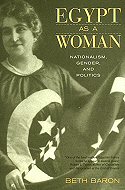|
Egypt as a Woman: Nationalism, Gender and Politics
|
|
Beth Baron
|

|

From the Introduction
Unrest broke out in Egypt in March 1919 when the British, who had occupied the autonomous Ottoman province in 1882 and declared it a protectorate at the outset of World War I, arrested and deported leaders of the Wafd (literally, delegation) who sought to present Egyptian demands for independence at peace talks In Paris. Diverse groups in the city and countryside, including urban elite women, staged protests. Inspired by what came to be known as the revolution of 1919, Mahmud Mukhtar sculpted a work called Nahdat Misr (The Awakening of Egypt), which shows a peasant woman lifting her veil from her face with her left arm and placing her right arm on the back of a sphinx as it rises up on its forelegs […] Mukhtar's sculpture thus depicts modern Egypt as a woman. […] The press closely followed the progress of the carving of The Awakening of Egypt in a public square in front of the railroad station. The government planned a big ceremony for the unveiling of the status in 1928, to which foreign dignitaries and local notables were invited, and over which King Fuad's presided. But by the latter's explicit orders, and with few exceptions, Egyptians women were barred from the ceremony.
The almost complete absence of women from a national ceremony celebrating a sculpture in which a woman represented the nation epitomizes the paradox faced by women nationalists. Scholars have noted the inverse relationship between the prominence of female figures in the allegorization of nation and the degree of access granted women to the political apparatus of the state. […]
Egypt as a Woman explores the connections between gendered images of the nation and the politics of women nationalists. Its starts with the making of the nation in the nineteenth century and ends with the eclipse of a generation of political activists in the 1940s.[…]
Beth Baron is Professor of History at the City College and the City University of New York and Co-Director of the Middle East and Middle Eastern American Center and the Graduate Center of CUNY. She is the author of The Women's Awakening in Egypt' Culture, Society and the Press (1994) and the coeditor of Women in Middle Eastern History: Shifting Boundaries in Sex and Gender (1991) and Iran and Beyond: Essays in Middle Eastern History in Honor of Nikki R. Keddie (2002).
|
|
